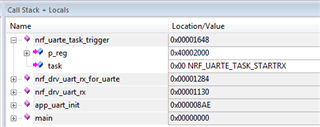I have the UART configured using the standard boiler plate code, with flow control enabled, where the RTS output is assigned pin 5.
I have defined a GPIOTE pin 25 as an output, with its initial state defined as Hi. I then set this output low using nrf_drv_gpiote_out_clear(opPin ); sure enough opPin goes low, however so does RTS.
This is 100% repeatable.
Any ideas?



